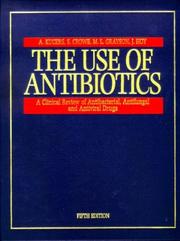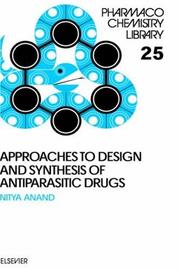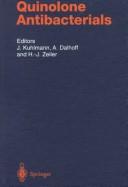| Listing 1 - 3 of 3 |
Sort by
|

ISBN: 0750601558 Year: 1997 Publisher: Buttorworth-Heinemann Oxford
Abstract | Keywords | Export | Availability | Bookmark
 Loading...
Loading...Choose an application
- Reference Manager
- EndNote
- RefWorks (Direct export to RefWorks)
Anti-Bacterial Agents --- Anti-infective agents. --- Antiinfectieux --- therapeutic use.

ISBN: 9780444894762 0444894764 9780080527529 0080527523 1281047643 9781281047649 9786611047641 Year: 1997 Publisher: Amsterdam New York Elsevier
Abstract | Keywords | Export | Availability | Bookmark
 Loading...
Loading...Choose an application
- Reference Manager
- EndNote
- RefWorks (Direct export to RefWorks)
This book presents a comprehensive and up to date account of the chemotherapy of parasitic diseases, both human and veterinary. The book starts with an overview of parasitic diseases. The body of the book is divided into two parts: antihelminthic drugs, and antiprotozoal drugs. Both parts start with chapters highlighting the 'biochemical targets' available for chemotherapeutic interference. Individual chapters deal with one chemical class of compounds and describe their origin, structure-activity relationship, mode of action, and methods of synthesis and their status both in clinical and veter
Antiparasitic agents. --- Pharmaceutical chemistry. --- Chemistry, Medical and pharmaceutical --- Chemistry, Pharmaceutical --- Drug chemistry --- Drugs --- Medical chemistry --- Medicinal chemistry --- Pharmacochemistry --- Chemistry --- Antiparasitics --- Parasiticides --- Anti-infective agents

ISBN: 3540625127 3642803660 3642803644 Year: 1997 Volume: 127 Publisher: Berlin ; Heidelberg ; New York Springer Verlag
Abstract | Keywords | Export | Availability | Bookmark
 Loading...
Loading...Choose an application
- Reference Manager
- EndNote
- RefWorks (Direct export to RefWorks)
It has been over 30 years since the first clinically important member of the quinolone class, nalidixic acid, was introduced into medical practice. The modification produced in the quinolone nucleus by introducing a fluorine at the 6-position led to the discovery of the newer fluoroquinolones with enhanced antibacterial activities as compared to nalidixic acid. By now a great deal of preclinical and clinical experience has been obtained with these agents. The intense interest in this class of antibacterial agents by chemists, micro biologists, toxicologists, pharmacologists, clinical pharmacologists, and clini cians in various disciplines encouraged us to summarize the information on the history, chemistry, mode of action and in vitro properties, kinetics and efficacy in animals, mechanisms of resistance, toxicity, clinical pharmacology, clinical experience, and future prospects in one volume of the Handbook of Experimental Pharmacology. As this series deals predominantly with "experimental" characteristics of drugs, our volume is dedicated specifically to quinolones and emphasizes principally their preclinical and clinical phar macological characteristics, despite the existence of several summaries on quinolones. The chemistry of the quinolones is described in detail. The chapter on the mode of action of quinolones reports the conclusive evidence that gyrase is the intracellular target of the quinolones; however, another enzyme, topoisomerase IV, may also be a target for quinolones, and the exact mechanisms by which quinolones act bactericidally are far from being understood.
Quinolone antibacterial agents --- Quinolone antimicrobial agents --- Quinolonen als antibacteriële agentia --- Quinolones comme antibactériens --- Anti-Infective Agents, Quinolone --- Quinolone antibacterial agents. --- Quinolones --- Therapeutic use. --- Pharmacology. --- Biochemistry. --- Microbiology. --- Internal medicine. --- Pharmacology/Toxicology. --- Biochemistry, general. --- Internal Medicine. --- Medicine, Internal --- Medicine --- Microbial biology --- Biology --- Microorganisms --- Biological chemistry --- Chemical composition of organisms --- Organisms --- Physiological chemistry --- Chemistry --- Medical sciences --- Drug effects --- Medical pharmacology --- Chemicals --- Chemotherapy --- Drugs --- Pharmacy --- Composition --- Physiological effect --- Ketoquinolines --- Oxoquinolines --- Quinolinones --- Antibacterial agents --- Synthetic drugs
| Listing 1 - 3 of 3 |
Sort by
|

 Search
Search Feedback
Feedback About
About Help
Help News
News